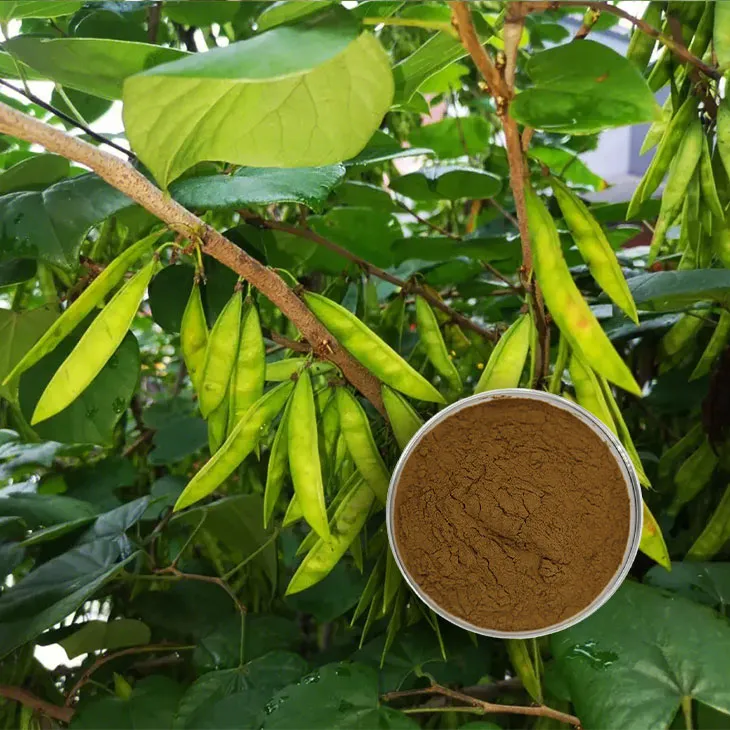- 0086-571-85302990
- sales@greenskybio.com
The Science Behind Saponin Extraction: Elevating the Quality of Cannabinoid-Rich Hemp Oil
2024-08-09

1. Introduction
Hemp oil, especially that which is rich in cannabinoids, has gained significant attention in recent years due to its potential therapeutic and health - promoting properties. However, the quality of hemp oil can vary greatly depending on various factors, one of which is the presence and extraction of saponins. Saponins are a group of natural compounds that can have a profound impact on the overall quality of hemp oil in terms of purity, potency, and stability.

2. What are Saponins?
2.1 Chemical Structure
Saponins are glycosides, which means they consist of a sugar molecule (glycone) attached to a non - sugar moiety known as the aglycone. The aglycone part is usually a steroid or triterpene. This unique structure gives saponins their characteristic properties. For example, they are amphiphilic, which means they have both hydrophilic (water - loving) and hydrophobic (water - hating) regions. This property is crucial in their extraction and interaction with other components in hemp oil.
2.2 Occurrence in Hemp
Saponins are naturally present in hemp plants. They are found in various parts of the plant, including the leaves, stems, and seeds. The concentration of saponins can vary depending on the hemp variety, growing conditions, and stage of growth. Understanding their natural occurrence is important for optimizing their extraction from hemp during the production of hemp oil.
3. The Importance of Saponin Extraction in Hemp Oil Production
3.1 Impact on Purity
- Removal of Impurities: Saponin Extraction can help in removing other unwanted compounds from hemp oil. Since saponins have the ability to bind to certain substances, they can be used as a means of purifying the hemp oil. For example, they can bind to proteins and other macromolecules that may be present as impurities in the crude hemp oil extract.
- Separation from Unwanted Phytochemicals: Hemp contains a wide variety of phytochemicals. Some of these may not be desirable in the final hemp oil product. Saponin Extraction can be a way to selectively separate the cannabinoid - rich fraction from other phytochemicals, thus increasing the purity of the cannabinoid - rich hemp oil.
3.2 Influence on Potency
- Enhanced Absorption of Cannabinoids: Saponins can act as emulsifiers. In the context of hemp oil, they can help in the emulsification of cannabinoids, which may lead to improved absorption in the body. When cannabinoids are better absorbed, their potency is effectively increased. For example, if a person consumes hemp oil with well - emulsified cannabinoids, a smaller dose may have a more significant physiological effect compared to hemp oil with poorly emulsified cannabinoids.
- Protection of Cannabinoids: Saponins can also protect cannabinoids from degradation. By forming complexes with cannabinoids, they can shield them from environmental factors such as light, heat, and oxygen that can cause the breakdown of cannabinoids. This protection helps in maintaining the potency of the hemp oil over time.
3.3 Role in Stability
- Oxidative Stability: Hemp oil is prone to oxidation due to the presence of unsaturated fatty acids and cannabinoids. Saponins can act as antioxidants in the hemp oil. They can scavenge free radicals and prevent the oxidative degradation of the oil components. This helps in maintaining the stability of the hemp oil, both during storage and in the final product.
- Emulsion Stability: As mentioned earlier, saponins are amphiphilic. This property makes them excellent emulsifiers. In hemp oil products that are formulated as emulsions (such as those combined with other liquids for better administration), saponins can help in maintaining the stability of the emulsion. A stable emulsion ensures that the cannabinoids are evenly distributed throughout the product and do not separate over time.

4. The Science of Saponin Extraction
4.1 Solvent - Based Extraction
- Choice of Solvent: Different solvents can be used for saponin extraction from hemp. Commonly used solvents include ethanol, methanol, and ethyl acetate. The choice of solvent depends on several factors, such as the solubility of saponins in the solvent, the selectivity of the solvent for saponins over other compounds, and the safety and cost - effectiveness of the solvent. For example, ethanol is a popular choice as it is relatively safe, can dissolve a wide range of saponins, and is cost - effective.
- Extraction Process: In solvent - based extraction, the hemp material (usually dried and ground) is soaked in the solvent for a certain period. The solvent penetrates the plant material and dissolves the saponins. After extraction, the solvent - saponin mixture is separated from the plant residue, usually by filtration. The saponins can then be further purified from the solvent, for example, by evaporation of the solvent under controlled conditions.
4.2 Supercritical Fluid Extraction
- Principle of Supercritical Fluids: Supercritical fluid extraction (SFE) uses a supercritical fluid, typically carbon dioxide (CO₂), as the extraction medium. A supercritical fluid has properties between those of a liquid and a gas. CO₂ becomes supercritical at a specific temperature and pressure (above 31.1°C and 73.8 bar). In this state, it has a high diffusivity like a gas and a high density like a liquid, which makes it an excellent solvent for extracting saponins from hemp.
- Advantages over Traditional Solvent Extraction: SFE has several advantages over solvent - based extraction. It is a cleaner process as CO₂ is non - toxic, non - flammable, and leaves no solvent residue in the final product. It also offers better selectivity for saponins, as the extraction conditions can be precisely controlled to target specific compounds. Additionally, the extraction process can be carried out at relatively low temperatures, which helps in preserving the integrity of the cannabinoids and other heat - sensitive components in hemp oil.
- Extraction Procedure: In SFE, the hemp material is placed in an extraction vessel. Supercritical CO₂ is passed through the vessel at the appropriate temperature and pressure. The saponins are dissolved in the supercritical CO₂, which is then passed through a separator where the pressure is reduced. This causes the CO₂ to return to its gaseous state, leaving the saponins behind for collection.

5. Factors Affecting Saponin Extraction Efficiency
5.1 Particle Size of Hemp Material
The size of the hemp particles plays an important role in saponin extraction. Smaller particles have a larger surface area, which allows for better contact between the hemp material and the extraction solvent or supercritical fluid. This increased contact area can lead to higher extraction efficiency. For example, if the hemp is ground into a fine powder, the solvent or supercritical fluid can more easily penetrate the plant material and dissolve the saponins.
5.2 Extraction Time
- Solvent - Based Extraction: In solvent - based extraction, the extraction time needs to be optimized. Longer extraction times may lead to higher yields of saponins, but it may also increase the extraction of unwanted compounds. There is a balance to be struck. For example, if ethanol extraction is carried out for too long, not only saponins but also other water - soluble impurities may be extracted, reducing the purity of the saponin extract.
- Supercritical Fluid Extraction: Similarly, in SFE, the extraction time affects the amount of saponins extracted. However, since SFE is a more selective process, the impact of over - extraction of unwanted compounds is generally less significant compared to solvent - based extraction. Nevertheless, an appropriate extraction time is still crucial to achieve high - quality saponin extracts.
5.3 Temperature and Pressure (in Supercritical Fluid Extraction)
In supercritical fluid extraction using CO₂, the temperature and pressure conditions are critical. Different saponins may have different solubility characteristics in supercritical CO₂ at different temperatures and pressures. By carefully adjusting these parameters, it is possible to optimize the extraction of saponins while minimizing the extraction of other compounds. For example, increasing the pressure may increase the solubility of saponins in supercritical CO₂, but it may also increase the solubility of other unwanted components if the pressure is too high.6. Challenges and Future Directions in Saponin Extraction for Hemp Oil Quality Improvement
6.1 Challenges
- Complexity of Hemp Matrix: Hemp contains a complex mixture of compounds, which makes the selective extraction of saponins challenging. There is a need to develop extraction methods that can specifically target saponins without co - extracting large amounts of other unwanted substances.
- Cost - Effectiveness: While supercritical fluid extraction offers many advantages, it is often more expensive compared to solvent - based extraction. Finding ways to make SFE more cost - effective without sacrificing the quality of the saponin extract is an ongoing challenge.
- Scale - Up: Scaling up saponin extraction processes from the laboratory scale to industrial production can be difficult. There may be issues related to equipment design, process control, and maintaining consistent product quality at a larger scale.
6.2 Future Directions
- Advanced Extraction Technologies: Research into new extraction technologies, such as microwave - assisted extraction or ultrasound - assisted extraction, may offer more efficient and selective ways to extract saponins from hemp. These methods can potentially reduce extraction times, increase yields, and improve the quality of the saponin extract.
- Genetic Engineering of Hemp: By genetically engineering hemp plants, it may be possible to increase the concentration of saponins in the plant or modify their chemical structure in a way that makes extraction easier and more efficient. This could lead to higher - quality hemp oil with enhanced saponin - related properties.
- Combined Extraction and Purification Processes: Developing integrated extraction and purification processes that can simultaneously extract saponins and purify them in a single step could simplify the production process and improve the overall quality of the hemp oil product.
7. Conclusion
Saponin extraction is a crucial aspect of cannabinoid - rich hemp oil production. Understanding the science behind saponin extraction, including their chemical nature, extraction methods, and factors affecting extraction efficiency, is essential for elevating the quality of hemp oil in terms of purity, potency, and stability. While there are currently challenges in saponin extraction, future research and development in this area hold great promise for further improving the quality of hemp oil and unlocking its full potential in various applications, from health and wellness to industrial uses.
FAQ:
What is saponin extraction in cannabinoid - rich hemp oil?
Saponin extraction in cannabinoid - rich hemp oil is the process of isolating saponins from the hemp oil. Saponins are a group of natural compounds with surfactant - like properties. In the context of hemp oil, this extraction is crucial as it can influence various aspects of the oil's quality.
Why is saponin extraction important for the purity of cannabinoid - rich hemp oil?
Saponin extraction is important for purity because saponins, if left in the hemp oil, can be considered impurities. Removing them helps to obtain a purer form of the cannabinoid - rich hemp oil. This is beneficial as it allows for more accurate dosing and a cleaner product profile, which is especially important in applications where high - purity hemp oil is required, such as in some medical or high - end consumer products.
How does saponin extraction impact the potency of cannabinoid - rich hemp oil?
The impact on potency is related to the fact that saponin extraction can remove substances that may interfere with the activity of cannabinoids. By eliminating these potentially interfering compounds, the cannabinoids in the hemp oil can be more effective. This means that the overall potency of the oil, in terms of its cannabinoid - related effects, can be enhanced.
What role does saponin extraction play in the stability of cannabinoid - rich hemp oil?
Saponin extraction can play a significant role in the stability of cannabinoid - rich hemp oil. Saponins can sometimes react with other components in the oil or with environmental factors, leading to instability. By removing saponins, the hemp oil is less likely to undergo unwanted chemical reactions, which helps in maintaining its stability over time. Stable hemp oil is important for proper storage and long - term usability.
What are the common methods used for saponin extraction in cannabinoid - rich hemp oil?
Common methods for saponin extraction include solvent - based extraction methods. For example, using organic solvents like ethanol or methanol can selectively dissolve saponins, allowing for their separation from the hemp oil. Another method could be chromatography - based techniques, which can be more precise in separating saponins based on their chemical properties. However, the choice of method depends on various factors such as cost, efficiency, and the desired quality of the final hemp oil product.
Related literature
- Saponin Chemistry and Biological Activities in Hemp"
- "The Role of Saponin Extraction in Optimizing Hemp Oil Quality"
- "Advanced Techniques for Saponin Isolation in Cannabinoid - Rich Oils"
- ▶ Hesperidin
- ▶ Citrus Bioflavonoids
- ▶ Plant Extract
- ▶ lycopene
- ▶ Diosmin
- ▶ Grape seed extract
- ▶ Sea buckthorn Juice Powder
- ▶ Fruit Juice Powder
- ▶ Hops Extract
- ▶ Artichoke Extract
- ▶ Mushroom extract
- ▶ Astaxanthin
- ▶ Green Tea Extract
- ▶ Curcumin
- ▶ Horse Chestnut Extract
- ▶ Other Product
- ▶ Boswellia Serrata Extract
- ▶ Resveratrol
- ▶ Marigold Extract
- ▶ Grape Leaf Extract
- ▶ New Product
- ▶ Aminolevulinic acid
- ▶ Cranberry Extract
- ▶ Red Yeast Rice
- ▶ Red Wine Extract
-
Licorice Root Extract Powder
2024-08-09
-
Ginseng Root Extract
2024-08-09
-
Dan Shen Root Extract/Salvia Root Extract
2024-08-09
-
Mulberry Extract
2024-08-09
-
Black Rice Extract
2024-08-09
-
Dandelion Leaf Extract
2024-08-09
-
Rosemary extract
2024-08-09
-
Elderberry Extract
2024-08-09
-
Stevia Extract
2024-08-09
-
Phellodendron Extract
2024-08-09





















